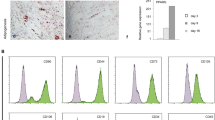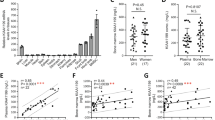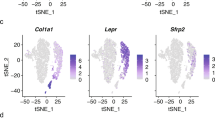Abstract
Human postnatal bone marrow stromal stem cells (BMSSCs) have a limited life-span and progressively lose their stem cell properties during ex vivo expansion. Here we report that ectopic expression of human telomerase reverse transcriptase (hTERT) in BMSSCs extended their life-span and maintained their osteogenic potential. In xenogenic transplants, hTERT-expressing BMSSCs (BMSSC-Ts) generated more bone tissue, with a mineralized lamellar bone structure and associated marrow, than did control BMSSCs. The enhanced bone-forming ability of BMSSC-Ts was correlated with a higher and sustained expression of the early pre-osteogenic stem cell marker STRO-1, indicating that telomerase expression helped to maintain the osteogenic stem cell pool during ex vivo expansion. These results show that telomerase expression can overcome critical technical barriers to the ex vivo expansion of BMSSCs, and suggest that telomerase therapy may be a useful strategy for bone regeneration and repair.
This is a preview of subscription content, access via your institution
Access options
Subscribe to this journal
Receive 12 print issues and online access
$209.00 per year
only $17.42 per issue
Buy this article
- Purchase on Springer Link
- Instant access to full article PDF
Prices may be subject to local taxes which are calculated during checkout





Similar content being viewed by others
References
Vaziri, H. et al. Loss of telomeric DNA during aging of normal and trisomy 21 human lymphocytes. Am. J. Hum. Genet. 52, 661–667 (1993).
Harley, C.B., Futcher, A.B. & Greider, C.W. Telomeres shorten during ageing of human fibroblasts. Nature 345, 458–460 (1990).
Allsopp, R.C. et al. Telomere length predicts replicative capacity of human fibroblasts. Proc. Natl. Acad. Sci. USA 89, 10114–10118 (1992).
Lingner, J. et al. Reverse transcriptase motifs in the catalytic subunit of telomerase. Science 276, 561–567 (1997).
Broccoli, D., Young, J.W. & de Lange, T. Telomerase activity in normal and malignant hematopoietic cells. Proc. Natl. Acad. Sci. USA 92, 9082–9086 (1995).
Counter, C.M. et al. Telomere shortening associated with chromosome instability is arrested in immortal cells which express telomerase activity. EMBO J. 11, 1921–1929 (1992).
Vaziri, H. & Benchimol, S. Reconstitution of telomerase activity in normal human cells leads to elongation of telomeres and extended replicative life span. Curr. Biol. 8, 279–282 (1998).
Nakamura, T.M. et al. Telomerase catalytic subunit homologs from fission yeast and human. Science 277, 955–959 (1997).
Bodnar, A.G. et al. Extension of life-span by introduction of telomerase into normal human cells. Science 279, 349–352 (1998).
Wright, W.E., Piatyszek, M.A., Rainey, W.E., Byrd, W. & Shay, J.W. Telomerase activity in human germline and embryonic tissues and cells. Dev. Genet. 18, 173–179 (1996).
Xu, C. et al. Feeder-free growth of undifferentiated human embryonic stem cell. Nat. Biotechnol. 19, 971–974 (2001).
Lee, S., Lumelsky, N., Studer, L., Auerbach J.M., & McKay, R.D. Efficient generation of midbrain and hindbrain neurons from mouse embryonic stem cells. Nat. Biotechnol. 18, 675–679 (2000).
Keyoung, H.M. et al. High-yield selection and extraction of two promoter-defined phenotypes of neural stem cells from the fetal human brain. Nat. Biotechnol. 19, 843–850 (2001).
Thomas, M., Yang, L. & Hornsby, P.J. Formation of functional tissue from transplanted adrenocortical cells expressing telomerase reverse transcriptase. Nat. Biotechnol. 18, 39–42 (2000).
Yang, J. et al. Telomerized human microvasculature is functional in vivo. Nat. Biotechnol. 19, 219–224 (2001).
Hahn, W.C. et al. Creation of human tumour cells with defined genetic elements. Nature 400, 464–468 (1999).
Kim, N.W. et al. Specific association of human telomerase activity with immortal cells and cancer. Science 266, 2011–2015 (1994).
Greider, C.W. & Blackburn, E.H. A telomeric sequence in the RNA of Tetrahymena telomerase required for telomere repeat synthesis. Nature 337, 331–337 (1989).
Feng, J. et al. The RNA component of human telomerase. Science 269, 1236–1241 (1995).
Pittenger, M.F. et al. Multilineage potential of adult human mesenchymal stem cells. Science 284, 143–147 (1999).
Rodan, G.A. & Martin, T.J. Therapeutic approaches to bone diseases. Science 289, 1508–1515 (2000).
Roholl, P.J., Blauw, E., Zurcher, C., Dormans, J.A. & Theuns, H.M. Evidence for a diminished maturation of preosteoblasts into osteoblasts during aging in rats: an ultrastructural analysis. J. Bone Miner. Res. 9, 355–366 (1994).
Inoue, K. et al. The effect of aging on bone formation in porous hydroxyapatite: biochemical and histological analysis. J. Bone Miner. Res. 12, 989–994 (1997).
Bergman, R.J. et al. Age-related changes in osteogenic stem cells in mice. J. Bone Miner. Res. 11, 568–577 (1996).
Rudolph, K.L. et al. Longevity, stress response, and cancer in aging telomerase-deficient mice. Cell 96, 701–712 (1999).
Yudoh, K., Matsuno, H., Nakazawa, F., Katayama, R. & Kimura, T. Reconstituting telomerase activity using the telomerase catalytic subunit prevents the telomere shorting and replicative senescence in human osteoblasts. J. Bone Miner. Res. 16, 1453–1464 (2001).
Caplan, A.I. & Bruder, S.P. Mesenchymal stem cells: building blocks for molecular medicine in the 21st century. Trends Mol. Med. 7, 259–264 (2001).
Krebsbach, P.H. et al. Bone formation in vivo: comparison of osteogenesis by transplanted mouse and human marrow stromal fibroblasts. Transplantation 63, 1059–1069 (1997).
Bianco, P., Riminucci, M., Gronthos, S. & Robey, P.G. Bone marrow stromal stem cells: nature, biology, and potential applications. Stem Cells 19, 180–192 (2001).
Reddi, A.H. Morphogenesis and tissue engineering of bone and cartilage: inductive signals, stem cells, and biomimetic biomaterials. Tissue Eng. 6, 351–359 (2000).
Gronthos, S. et al. Differential cell surface expression of the STRO-1 and alkaline phosphatase antigens on discrete developmental stages in primary cultures of human bone cells. J. Bone Miner. Res. 14, 47–56 (1999).
Gimble, J.M. et al. Bone morphogenetic proteins inhibit adipocyte differentiation by bone marrow stromal cells. J. Cell. Biochem. 58, 393–402 (1995).
Gronthos, S., Mankani, M., Brahim, J., Robey, P.G. & Shi, S. Postnatal human dental pulp stem cells (DPSCs) in vitro and in vivo. Proc. Natl. Acad. Sci. USA 97, 13625–13630 (2000).
Stewart, K. et al. Further characterization of cells expressing STRO-1 in cultures of adult human bone marrow stromal cells. J. Bone Miner. Res. 14, 1345–1356 (1999).
Saito, N. et al. A biodegradable polymer as a cytokine delivery system for inducing bone formation. Nat. Biotechnol. 19, 332–335 (2001).
Prockop, D.J. Marrow stromal cells as stem cells for nonhematopoietic tissues. Science 276, 71–74 (1997).
Ducy, P., Schinke, T. & Karsenty, G. The osteoblast: a sophisticated fibroblast under central surveillance. Science 289, 1501–1504 (2000).
Kon, E. et al. Autologous bone marrow stromal cells loaded onto porous hydroxyapatite ceramic accelerate bone repair in critical-size defects of sheep long bones. J. Biomed. Mater. Res. 49, 328–337 (2000).
Petite, H. et al. Tissue-engineered bone regeneration. Nat. Biotechnol. 18, 959–963 (2000).
Nishida, S. et al. Number of osteoprogenitor cells in human bone marrow markedly decreases after skeletal maturation. J. Bone Miner. Metab. 17, 171–177 (1999).
Mueller, S.M. & Glowacki, J. Age-related decline in the osteogenic potential of human bone marrow cells cultured in three-dimensional collagen sponges. J. Cell. Biochem. 82, 583–590 (2001).
Muschler, G.F., Nitto, H., Boehm, C.A. & Easley, K.A. Age- and gender-related changes in the cellularity of human bone marrow and the prevalence of osteoblastic progenitors. J. Orth. Res. 19, 117–125 (2001).
Hackett, J.A., Feldser, D.M. & Greider, C.W. Telomere dysfunction increases mutation rate and genomic instability. Cell 106, 275–286 (2001).
Morales, C.P. et al. Absence of cancer-associated changes in human fibroblasts immortalized with telomerase. Nat. Genet. 21, 115–118 (1999).
Rudolph, K.L., Chang, S., Millard, M., Schreiber-Agus, N. & DePinho, R.A. Inhibition of experimental liver cirrhosis in mice by telomerase gene delivery. Science 287, 1253–1258 (2000).
Wyllie, F.S. et al. Telomerase prevents the accelerated cell ageing of Werner syndrome fibroblasts. Nat. Genet. 24, 16–17 (2000).
Kuznetsov, S.A. et al. Single-colony derived strains of human marrow stromal fibroblasts form bone after transplantation in vivo. J. Bone Miner. Res. 12, 1335–1347 (1997).
Acknowledgements
We thank R. Weinberg for providing plasmids. This work was supported by research grants from the National Institutes of Health (National Institute of Dental and Craniofacial Research) to C.-Y. Wang.
Author information
Authors and Affiliations
Corresponding author
Ethics declarations
Competing interests
The authors declare no competing financial interests.
Supplementary information
Rights and permissions
About this article
Cite this article
Shi, S., Gronthos, S., Chen, S. et al. Bone formation by human postnatal bone marrow stromal stem cells is enhanced by telomerase expression. Nat Biotechnol 20, 587–591 (2002). https://doi.org/10.1038/nbt0602-587
Received:
Accepted:
Issue Date:
DOI: https://doi.org/10.1038/nbt0602-587
This article is cited by
-
Mesenchymal stem cell-derived apoptotic bodies alleviate alveolar bone destruction by regulating osteoclast differentiation and function
International Journal of Oral Science (2023)
-
Telomeres and Mitochondrial Metabolism: Implications for Cellular Senescence and Age-related Diseases
Stem Cell Reviews and Reports (2022)
-
Regenerative Potential of DPSCs and Revascularization: Direct, Paracrine or Autocrine Effect?
Stem Cell Reviews and Reports (2021)
-
Extracellular vesicles from deciduous pulp stem cells recover bone loss by regulating telomerase activity in an osteoporosis mouse model
Stem Cell Research & Therapy (2020)
-
Dose-dependent roles of aspirin and other non-steroidal anti-inflammatory drugs in abnormal bone remodeling and skeletal regeneration
Cell & Bioscience (2019)



